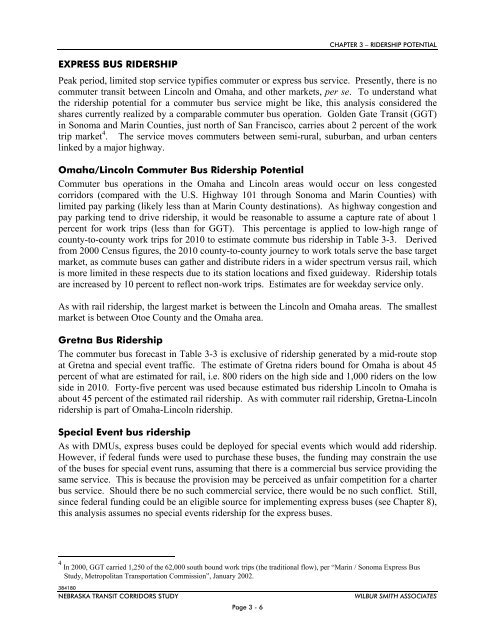NTRAC Final Study - Nebraska Department of Roads - State of ...
NTRAC Final Study - Nebraska Department of Roads - State of ...
NTRAC Final Study - Nebraska Department of Roads - State of ...
You also want an ePaper? Increase the reach of your titles
YUMPU automatically turns print PDFs into web optimized ePapers that Google loves.
CHAPTER 3 – RIDERSHIP POTENTIAL<br />
EXPRESS BUS RIDERSHIP<br />
Peak period, limited stop service typifies commuter or express bus service. Presently, there is no<br />
commuter transit between Lincoln and Omaha, and other markets, per se. To understand what<br />
the ridership potential for a commuter bus service might be like, this analysis considered the<br />
shares currently realized by a comparable commuter bus operation. Golden Gate Transit (GGT)<br />
in Sonoma and Marin Counties, just north <strong>of</strong> San Francisco, carries about 2 percent <strong>of</strong> the work<br />
trip market 4 . The service moves commuters between semi-rural, suburban, and urban centers<br />
linked by a major highway.<br />
Omaha/Lincoln Commuter Bus Ridership Potential<br />
Commuter bus operations in the Omaha and Lincoln areas would occur on less congested<br />
corridors (compared with the U.S. Highway 101 through Sonoma and Marin Counties) with<br />
limited pay parking (likely less than at Marin County destinations). As highway congestion and<br />
pay parking tend to drive ridership, it would be reasonable to assume a capture rate <strong>of</strong> about 1<br />
percent for work trips (less than for GGT). This percentage is applied to low-high range <strong>of</strong><br />
county-to-county work trips for 2010 to estimate commute bus ridership in Table 3-3. Derived<br />
from 2000 Census figures, the 2010 county-to-county journey to work totals serve the base target<br />
market, as commute buses can gather and distribute riders in a wider spectrum versus rail, which<br />
is more limited in these respects due to its station locations and fixed guideway. Ridership totals<br />
are increased by 10 percent to reflect non-work trips. Estimates are for weekday service only.<br />
As with rail ridership, the largest market is between the Lincoln and Omaha areas. The smallest<br />
market is between Otoe County and the Omaha area.<br />
Gretna Bus Ridership<br />
The commuter bus forecast in Table 3-3 is exclusive <strong>of</strong> ridership generated by a mid-route stop<br />
at Gretna and special event traffic. The estimate <strong>of</strong> Gretna riders bound for Omaha is about 45<br />
percent <strong>of</strong> what are estimated for rail, i.e. 800 riders on the high side and 1,000 riders on the low<br />
side in 2010. Forty-five percent was used because estimated bus ridership Lincoln to Omaha is<br />
about 45 percent <strong>of</strong> the estimated rail ridership. As with commuter rail ridership, Gretna-Lincoln<br />
ridership is part <strong>of</strong> Omaha-Lincoln ridership.<br />
Special Event bus ridership<br />
As with DMUs, express buses could be deployed for special events which would add ridership.<br />
However, if federal funds were used to purchase these buses, the funding may constrain the use<br />
<strong>of</strong> the buses for special event runs, assuming that there is a commercial bus service providing the<br />
same service. This is because the provision may be perceived as unfair competition for a charter<br />
bus service. Should there be no such commercial service, there would be no such conflict. Still,<br />
since federal funding could be an eligible source for implementing express buses (see Chapter 8),<br />
this analysis assumes no special events ridership for the express buses.<br />
4 In 2000, GGT carried 1,250 <strong>of</strong> the 62,000 south bound work trips (the traditional flow), per “Marin / Sonoma Express Bus<br />
<strong>Study</strong>, Metropolitan Transportation Commission”, January 2002.<br />
384180<br />
NEBRASKA TRANSIT CORRIDORS STUDY<br />
Page 3 - 6<br />
WILBUR SMITH ASSOCIATES

















